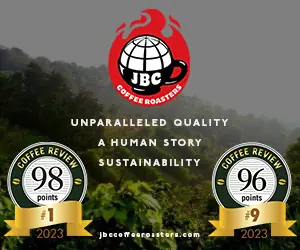Proper Aroma/Flavor profiling is all too often neglected in Coffee. Coffee Aromas/Flavors are essential to understanding and appreciating coffee. As in wine, coffee gets its aromas or flavors from the soil and the climatic environment in which the coffee plant grows. The coffee variety (genetic) and the method in which the green coffee was processed also contribute to the aromas/flavors. Like wine, coffee has many variables which can affect its quality. Coffee crops can be harmed by insects, freeze and poor storage conditions during harvest, which may lead to moldy and sour flavors. It can also be contaminated during its processing such as in the depulping and washing of the coffee cherries, and lastly, during the final storage conditions where once again several defects can develop on the beans. These problems are not exactly the same but similar to those which occur during wine production. Coffee has different varieties, as does wine, which get their characteristics from the soil (terroir). The core aromatic profile of the end product (in the cup) is defined by these characteristics and by the roasters. The coffee blender creates the finishing touch by assembling different roasts. This is very similar to what consulting winemakers do during the wine blending process. We talk about taste, aromas, flavors, acidity and body in coffee as we do in wine. The main difference between coffee and wine, taste aside, is that coffee is not rated by vintage. Unlike certain wines, roasted coffee does not keep for years. The fresher the roast, the more aromatic the coffee beverage will be. Let it age and you will create unpleasant tastes and aromas; this is especially true for the volatile aromas. The consumer also has an important hand in the outcome of her/his coffee experience as does the wine consumer. In wine, serving temperature, wine glass shape and proper food pairing play an important role in properly enjoying a wine. In coffee this process is a little different. The important factors are the grinding, blending and brewing process. The grinding size and the water temperature play major roles in the proper extraction of coffee aromas/flavors, as well as the quantity and quality of water used to prepare a good cup of coffee. Ultimately, the coffee drinker puts her/his final touch to the coffee beverage.
In coffee, over 850 volatile aromatic compounds have been catalogued to date. That said, most aromatic descriptions have been simplified or regrouped in terms of flavors and taste. Common flavors found in coffee are fruity, floral, earthy, buttery, caramel, nutty, spicy, smoky, etc. The classification of taste includes acid, bitter, body (thin, watery to thick, heavy). This simplification helps coffee drinkers express their preferences in a basic way. If one wants to gain further knowledge of coffee tasting, then it is imperative to recognize key aromas and flavors in coffee. Especially if you wish to narrow down the country of origin, variety and profile. One would then be able to differentiate between a Robusta from South East Asia with one from Brazil. This is something we have been doing for years with wine and which has been available to every wine aficionados for more than 30 years through le nez du vin (Wine Aroma Kits). Using the same methodology, Jean Lenoir, creator of the famous Wine Aroma kits, created two le nez du café (or make scents of coffee) kits. The first kit is an introduction that includes the 6 most commonly found coffee aromas:
(1) Garden peas, 2) Blackcurrant-like, 3) Butter, 4) Caramel, 5) Roasted peanuts, 6) Roasted coffee. The second, a more advanced and complete kit, contains the 36 most commonly found coffee aromas:
01) Earth , 02) Potato , 03) Garden peas, 04) Cucumber 05) Straw , 06) Cedar, 07) Clove-like , 08) Pepper, 09) Coriander seeds, 10) Vanilla, 11) Tea-roses/Redcurrant jelly, 12) Coffee blossom, 13) Coffee pulp, 14) Blackcurrant-like, 15) Lemon, 16)Apricot, 17) Apple, 18)Butter, 19) Honeyed, 20) Leather, 21) Basmati Rice, 22) Toast, 23) Malt, 24) Maple Syrup, 25) Caramel, 26) Dark chocolate, 27) Roasted almonds, 28) Roasted peanuts, 29) Roasted hazelnuts, 30) Walnuts, 31) Cooked beef, 32) Smoke, 33) Pipe Tobacco, 34) Roasted coffee, 35) Medicinal, 36) Rubber.
This unique and extensive collection of aromas will help you train your sense of smell and improve your enjoyment of coffee. The le nez du café (make scents of coffee) kits provide a common vocabulary to describe coffee aromas, taste and flavors because coffee deserves the same attention as wine.
It is no surprise that most coffee roasters and specialists from the world over use le nez du café to train their sense of smell and better understand the aromatics behind coffee.
So if you are passionate about your coffee and would like to become a better taster, understand where aromas and flavors originate and how they are associated with the varieties, le nez du café (make scents of coffee) kits are fundamental to the development of your coffee expertise.










